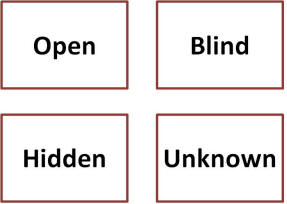The Johari window
The Johari window is a 4 section. 2x2 matrix. It is used to help identify and explore what we and others know about us, or a business problem. Each section covers a different area of knowledge and can be opened up using appropriate tools to to enable improvements and fixes to be implemented.

There are two interpretations of the Johari window
Interpretation 1: This was the original interpretation,
developed for a doctor and patient interaction, to explore what both
the doctor and patient know (or don't) about the patient. The
descriptions below are from the doctors viewpoint.
- Window 1 is "things that I know and you know". This is often called the "open" window and contains any information that is recognised and understood by all. issues that sit in this category can be easily identified and agreed for a fix.
- Window 2 is "things that you know that I don't know". This is called the "blind" window and contains things that we can find out about a problem if we ask other people for feedback!
- Window 3 is "things that I know but you don't" and is called the hidden window. It contains the things that I am hiding from others
- Window 4 is "things that neither you or I know" and is called the unknown window. We need to "discover" what is in this window using appropriate tools.
Interpretation 2: This was developed, I believe, during
the second world war to assess a situation, and explore what was
known and unknown about it. In this interpretation, there is no
doctor - patient relationship, all the participants are "on the same
side of the table".
- Window 1. What we know we know "open" - these are the things
we can list or brainstorm (e.g. issues and causes for a
problem). They are generally found quite quick and can be acted
upon.
- Top right: What we know we don't know "blind" - these are
the things that we know we need to find out (eg when we don't
know the cause of the problem), and are often found out by data
collection and analysis
- Bottom left: What we don't know we know "hidden" - this window contains things we can draw out of ourselves if we spend time together. They will be found through discovery, often by getting people together (e.g. from different functions) to share and discuss common issues.
- Bottom right: what we don't know we don't know "unknown" - this window is "unknown" but starts to open up (into the other windows) once we explore and investigate the above 3 windows.
In a business context the Johari window helps people agree that we don't know everything, and that tools are required if we are going to drive ever more improvement into the business. Problem solving always starts in Window 1. These are the quick wins that are recognised, and can therefore tend to get supported easily. However, once these dry up, structured methods (still quite simple) are required to explore the other windows. Many of the tools and methods elsewhere on this site help explore the other windows.